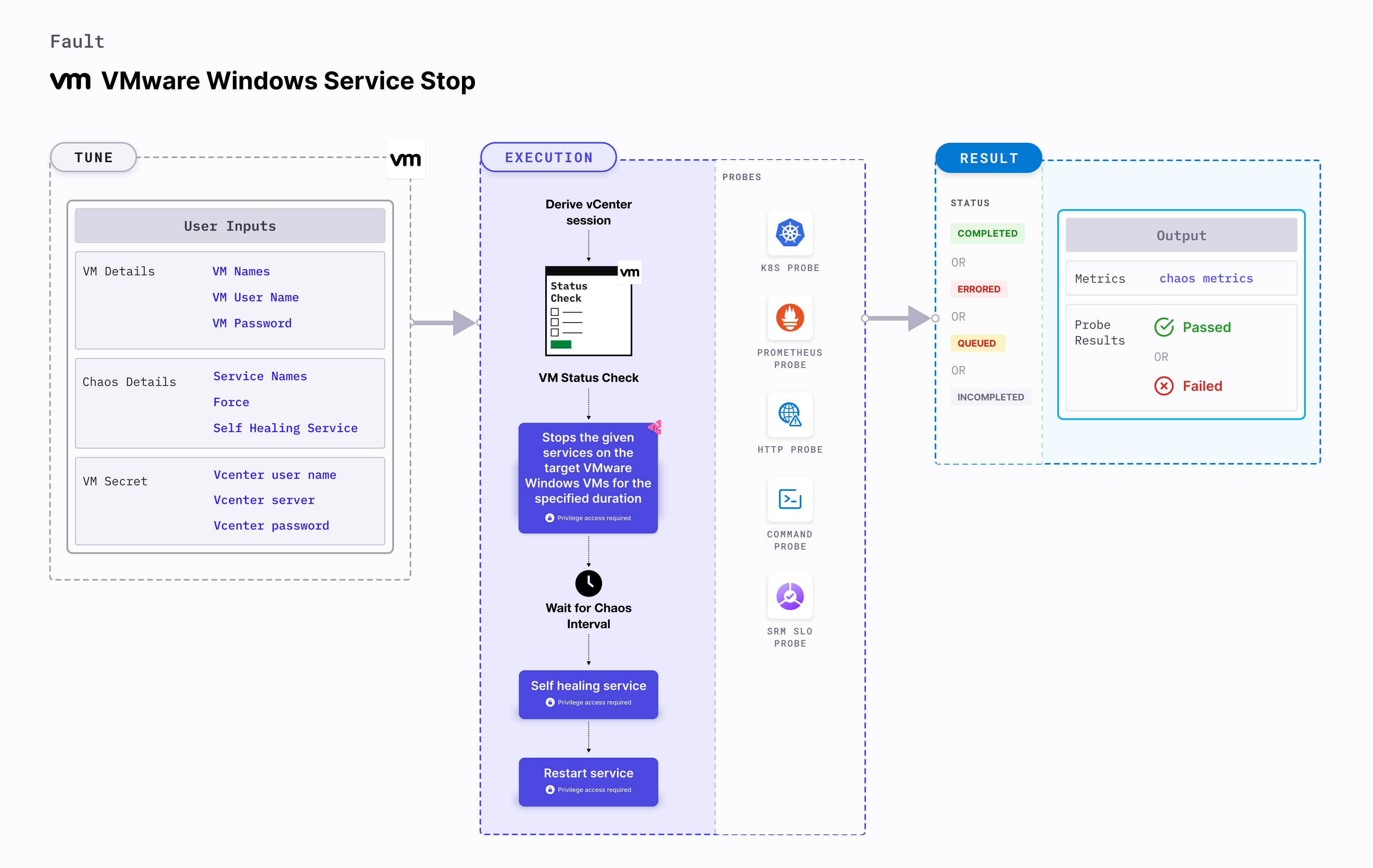VMware Windows Service Stop
VMware Windows Service Stop simulates a service stop scenario on Windows OS based VMware VM.
- It checks the performance of the application running on the VMware Windows VMs under service stop conditions.

Use cases
- VMware Windows Service Stop determines the resilience of an application when a service stop scenario is simulated on a VMware Windows virtual machine.
- VMware Windows Service Stop simulates the situation of service stop for services running on the application, which degrades their performance.
- It also helps verify the application's ability to handle service failures and its failover mechanisms.
Prerequisites
-
Kubernetes > 1.16 is required to execute this fault.
-
Execution plane should be connected to vCenter and host vCenter on port 443.
-
VMware tool should be installed on the target VM with remote execution enabled.
-
Adequate vCenter permissions should be provided to access the hosts and the VMs.
-
The VM should be in a healthy state before and after injecting chaos.
-
Kubernetes secret has to be created that has the Vcenter credentials in the
CHAOS_NAMESPACE. -
Run the fault with a user possessing admin rights, preferably the built-in Administrator, to guarantee permissions for memory stress testing. See how to enable the built-in Administrator in Windows.
-
VM credentials can be passed as secrets or as a chaos enginer environment variable.
apiVersion: v1
kind: Secret
metadata:
name: vcenter-secret
namespace: litmus
type: Opaque
stringData:
VCENTERSERVER: XXXXXXXXXXX
VCENTERUSER: XXXXXXXXXXXXX
VCENTERPASS: XXXXXXXXXXXXX
Mandatory tunables
| Tunable | Description | Notes |
|---|---|---|
| VM_NAME | Name of the target VM. | For example, win-vm-1 |
| VM_USER_NAME | Username of the target VM. | For example, vm-user. |
| VM_PASSWORD | User password for the target VM. | For example, 1234. Note: You can take the password from secret as well. |
| SERVICE_NAMES | Comma separated list of service names to stop. | For example, service1,service2. For more information, go to service names. |
Optional tunables
| Tunable | Description | Notes |
|---|---|---|
| FORCE | If set to "enable", the service will be forcefully stopped. | Default: enable. For more information, go to force. |
| SELF_HEALING_SERVICE | If set to "enable", the service will be restarted after chaos injection. | Default: disable. For more information, go to self-healing service. |
| TOTAL_CHAOS_DURATION | Duration that you specify, through which chaos is injected into the target resource (in seconds). | Default: 60 s. For more information, go to duration of the chaos. |
| RAMP_TIME | Period to wait before and after injecting chaos (in seconds). | Default: 0 s. For more information, go to ramp time. |
| SEQUENCE | Sequence of chaos execution for multiple instances. | Default: parallel. Supports serial and parallel sequence. For more information, go to sequence of chaos execution. |
| DEFAULT_HEALTH_CHECK | Determines if you wish to run the default health check which is present inside the fault. | Default: 'true'. For more information, go to default health check. |
Service names
The SERVICE_NAMES environment variable specifies the service names to stop on the target Windows VM.
Use the following example to specify service names:
apiVersion: litmuschaos.io/v1alpha1
kind: ChaosEngine
metadata:
name: engine-nginx
spec:
engineState: "active"
chaosServiceAccount: litmus-admin
experiments:
- name: vmware-windows-service-stop
spec:
components:
env:
# Name of the VM
- name: VM_NAME
value: 'test-vm-01'
# Service names to stop
- name: SERVICE_NAMES
value: 'service1,service2'
Force
The FORCE environment variable specifies whether the service should be forcefully stopped.
Use the following example to enable forceful stopping:
apiVersion: litmuschaos.io/v1alpha1
kind: ChaosEngine
metadata:
name: engine-nginx
spec:
engineState: "active"
chaosServiceAccount: litmus-admin
experiments:
- name: vmware-windows-service-stop
spec:
components:
env:
# Name of the VM
- name: VM_NAME
value: 'test-vm-01'
# Enable forceful stopping
- name: FORCE
value: 'enable'
Self-healing service
The SELF_HEALING_SERVICE environment variable specifies whether the service should be restarted after chaos injection.
Use the following example to enable self healing service:
apiVersion: litmuschaos.io/v1alpha1
kind: ChaosEngine
metadata:
name: engine-nginx
spec:
engineState: "active"
chaosServiceAccount: litmus-admin
experiments:
- name: vmware-windows-service-stop
spec:
components:
env:
# Name of the VM
- name: VM_NAME
value: 'test-vm-01'
# Enable self healing service
- name: SELF_HEALING_SERVICE
value: 'enable'